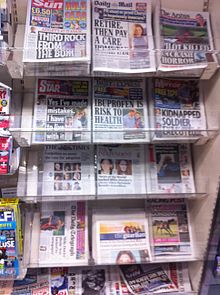
Tabloid journalism is a popular style of largely sensationalist journalism which takes its name from the tabloid newspaper format: a small-sized newspaper also known as half broadsheet.[1] The size became associated with sensationalism, and tabloid journalism replaced the earlier label of yellow journalism and scandal sheets.[2] Not all newspapers associated with tabloid journalism are tabloid size, and not all tabloid-size newspapers engage in tabloid journalism; in particular, since around the year 2000 many broadsheet newspapers converted to the more compact tabloid format.[1]
In some cases, celebrities have successfully sued tabloids for libel, demonstrating that their stories have defamed them.[3] Publications engaging in tabloid journalism are also known as rag newspapers or simply rags. Tabloid journalism has changed in the 21st century to more online platforms that seek to target and engage youth consumers with celebrity news and entertainment.
- ^ a b Gossel, Daniel. "Tabloid journalism". Encyclopedia Britannica. Archived from the original on 8 April 2022. Retrieved 19 September 2020.
- ^ Cohen, Daniel (2000). Yellow Journalism. Twenty-First Century Books. p. 73. ISBN 0761315020.
- ^ Andrews, Travis M. (14 July 2016). "Dr. Phil and wife Robin sue the National Enquirer for $250 million, citing defamation". The Washington Post. Archived from the original on 23 October 2021. Retrieved 13 January 2019.